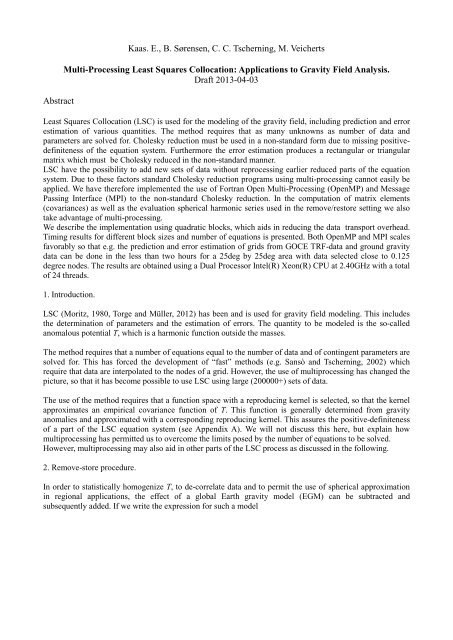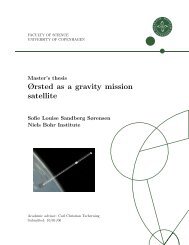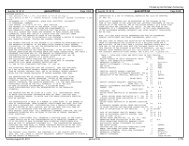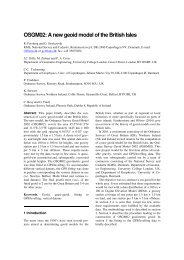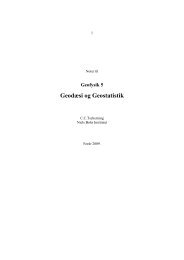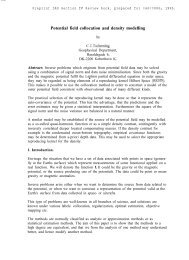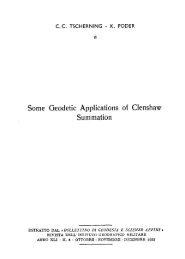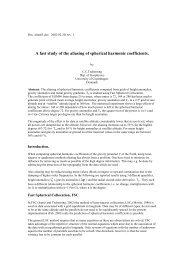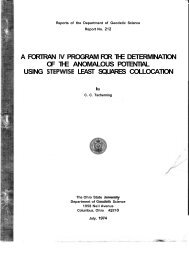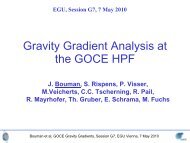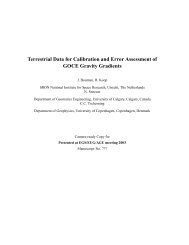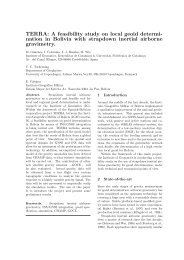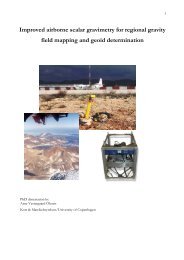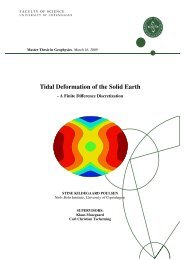Kaas. E., B. Sørensen, C. C. Tscherning, M. Veicherts Multi ...
Kaas. E., B. Sørensen, C. C. Tscherning, M. Veicherts Multi ...
Kaas. E., B. Sørensen, C. C. Tscherning, M. Veicherts Multi ...
You also want an ePaper? Increase the reach of your titles
YUMPU automatically turns print PDFs into web optimized ePapers that Google loves.
Abstract<br />
<strong>Kaas</strong>. E., B. <strong>Sørensen</strong>, C. C. <strong>Tscherning</strong>, M. <strong>Veicherts</strong><br />
<strong>Multi</strong>-Processing Least Squares Collocation: Applications to Gravity Field Analysis.<br />
Draft 2013-04-03<br />
Least Squares Collocation (LSC) is used for the modeling of the gravity field, including prediction and error<br />
estimation of various quantities. The method requires that as many unknowns as number of data and<br />
parameters are solved for. Cholesky reduction must be used in a non-standard form due to missing positivedefiniteness<br />
of the equation system. Furthermore the error estimation produces a rectangular or triangular<br />
matrix which must be Cholesky reduced in the non-standard manner.<br />
LSC have the possibility to add new sets of data without reprocessing earlier reduced parts of the equation<br />
system. Due to these factors standard Cholesky reduction programs using multi-processing cannot easily be<br />
applied. We have therefore implemented the use of Fortran Open <strong>Multi</strong>-Processing (OpenMP) and Message<br />
Passing Interface (MPI) to the non-standard Cholesky reduction. In the computation of matrix elements<br />
(covariances) as well as the evaluation spherical harmonic series used in the remove/restore setting we also<br />
take advantage of multi-processing.<br />
We describe the implementation using quadratic blocks, which aids in reducing the data transport overhead.<br />
Timing results for different block sizes and number of equations is presented. Both OpenMP and MPI scales<br />
favorably so that e.g. the prediction and error estimation of grids from GOCE TRF-data and ground gravity<br />
data can be done in the less than two hours for a 25deg by 25deg area with data selected close to 0.125<br />
degree nodes. The results are obtained using a Dual Processor Intel(R) Xeon(R) CPU at 2.40GHz with a total<br />
of 24 threads.<br />
1. Introduction.<br />
LSC (Moritz, 1980, Torge and Müller, 2012) has been and is used for gravity field modeling. This includes<br />
the determination of parameters and the estimation of errors. The quantity to be modeled is the so-called<br />
anomalous potential T, which is a harmonic function outside the masses.<br />
The method requires that a number of equations equal to the number of data and of contingent parameters are<br />
solved for. This has forced the development of “fast” methods (e.g. Sansò and <strong>Tscherning</strong>, 2002) which<br />
require that data are interpolated to the nodes of a grid. However, the use of multiprocessing has changed the<br />
picture, so that it has become possible to use LSC using large (200000+) sets of data.<br />
The use of the method requires that a function space with a reproducing kernel is selected, so that the kernel<br />
approximates an empirical covariance function of T. This function is generally determined from gravity<br />
anomalies and approximated with a corresponding reproducing kernel. This assures the positive-definiteness<br />
of a part of the LSC equation system (see Appendix A). We will not discuss this here, but explain how<br />
multiprocessing has permitted us to overcome the limits posed by the number of equations to be solved.<br />
However, multiprocessing may also aid in other parts of the LSC process as discussed in the following.<br />
2. Remove-store procedure.<br />
In order to statistically homogenize T, to de-correlate data and to permit the use of spherical approximation<br />
in regional applications, the effect of a global Earth gravity model (EGM) can be subtracted and<br />
subsequently added. If we write the expression for such a model
Abstract<br />
<strong>Kaas</strong>. E., B. <strong>Sørensen</strong>, C. C. <strong>Tscherning</strong>, M. <strong>Veicherts</strong><br />
<strong>Multi</strong>-Processing Least Squares Collocation: Applications to Gravity Field Analysis.<br />
Draft 2013-04-03<br />
Least Squares Collocation (LSC) is used for the modeling of the gravity field, including prediction and error<br />
estimation of various quantities. The method requires that as many unknowns as number of data and<br />
parameters are solved for. Cholesky reduction must be used in a non-standard form due to missing positivedefiniteness<br />
of the equation system. Furthermore the error estimation produces a rectangular or triangular<br />
matrix which must be Cholesky reduced in the non-standard manner.<br />
LSC have the possibility to add new sets of data without reprocessing earlier reduced parts of the equation<br />
system. Due to these factors standard Cholesky reduction programs using multi-processing cannot easily be<br />
applied. We have therefore implemented the use of Fortran Open <strong>Multi</strong>-Processing (OpenMP) and Message<br />
Passing Interface (MPI) to the non-standard Cholesky reduction. In the computation of matrix elements<br />
(covariances) as well as the evaluation spherical harmonic series used in the remove/restore setting we also<br />
take advantage of multi-processing.<br />
We describe the implementation using quadratic blocks, which aids in reducing the data transport overhead.<br />
Timing results for different block sizes and number of equations is presented. Both OpenMP and MPI scales<br />
favorably so that e.g. the prediction and error estimation of grids from GOCE TRF-data and ground gravity<br />
data can be done in the less than two hours for a 25deg by 25deg area with data selected close to 0.125<br />
degree nodes. The results are obtained using a Dual Processor Intel(R) Xeon(R) CPU at 2.40GHz with a total<br />
of 24 threads.<br />
1. Introduction.<br />
LSC (Moritz, 1980, Torge and Müller, 2012) has been and is used for gravity field modeling. This includes<br />
the determination of parameters and the estimation of errors. The quantity to be modeled is the so-called<br />
anomalous potential T, which is a harmonic function outside the masses.<br />
The method requires that a number of equations equal to the number of data and of contingent parameters are<br />
solved for. This has forced the development of “fast” methods (e.g. Sansò and <strong>Tscherning</strong>, 2002) which<br />
require that data are interpolated to the nodes of a grid. However, the use of multiprocessing has changed the<br />
picture, so that it has become possible to use LSC using large (200000+) sets of data.<br />
The use of the method requires that a function space with a reproducing kernel is selected, so that the kernel<br />
approximates an empirical covariance function of T. This function is generally determined from gravity<br />
anomalies and approximated with a corresponding reproducing kernel. This assures the positive-definiteness<br />
of a part of the LSC equation system (see Appendix A). We will not discuss this here, but explain how<br />
multiprocessing has permitted us to overcome the limits posed by the number of equations to be solved.<br />
However, multiprocessing may also aid in other parts of the LSC process as discussed in the following.<br />
2. Remove-store procedure.<br />
In order to statistically homogenize T, to de-correlate data and to permit the use of spherical approximation<br />
in regional applications, the effect of a global Earth gravity model (EGM) can be subtracted and<br />
subsequently added. If we write the expression for such a model
4. Reduction (factorization), solution of equations and error-estimation.<br />
The LSC method has been applied since the 1960’ties on computers with very small central processing units<br />
(CPU). Cholesky-reduction was used to reduce (not invert !) and solve the systems of equations. However<br />
often it was possible to store elements of equation systems on external media like a disk or drum. A simple<br />
implementation is described in (Poder and <strong>Tscherning</strong>, 1973) and used in the LSC implementation<br />
(<strong>Tscherning</strong>, 1974). Here the equations were divided in rectangular blocks, filling in as many columns as<br />
possible, and storing the blocks on an external media. However this implementation is not suitable for<br />
multiprocessing, where each row may be processed individually using Cholesky-reduction, see Appendix B.<br />
We therefore implemented a division of the matrices in square blocks called “chunks” like shown in Fig. (1).<br />
Cholesky reduction is used in eq. (A2) with details in Appendix B. This is followed by what is known as<br />
back-substitution and multiplication with the Cholesky-reduced in the other two equations, for details see<br />
(<strong>Tscherning</strong>, 1980). However, the concatenated set of matrices is not positive definite, due to the “minus”<br />
occurring in eq. (A2). This is however by-passed by using positive accumulation instead of negative<br />
accumulation in the Cholesky-algorithm, see eq. (B4) and (B5). But for the use of multiprocessing this<br />
causes difficulties, so that it is only used to reduce the chunks which do not contain a part of the A matrix.<br />
This is also the primary reason for that standard LAPAC or similar equation solvers can not be used. Another<br />
reason is that we want to be able to take advantage of the so-called permanency property (Freden, 1982),<br />
where new columns can be added to an already reduced system of equations, and the reduction then<br />
continued from the first chunk, which contains unreduced elements.<br />
⎡c11<br />
c12<br />
c13<br />
c14<br />
c15<br />
c16<br />
c17<br />
c18<br />
c19<br />
c110<br />
⎤<br />
⎢<br />
⎥<br />
⎢<br />
0 c22<br />
c23<br />
c24<br />
c25<br />
c26<br />
c27<br />
c28<br />
c29<br />
c210<br />
⎥<br />
⎢ 0 0 c<br />
⎥<br />
33 c34<br />
c35<br />
c36<br />
c37<br />
c38<br />
c39<br />
c310<br />
⎢<br />
⎥<br />
⎢ 0 0 0 c44<br />
c45<br />
c46<br />
c47<br />
c48<br />
c49<br />
c410<br />
⎥<br />
⎢ 0 0 0 0 c<br />
⎥<br />
55 c56<br />
c57<br />
c58<br />
c59<br />
c510<br />
⎢<br />
⎥<br />
⎢ 0 0 0 0 0 c66<br />
c67<br />
c68<br />
c69<br />
c610<br />
⎥<br />
⎢ 0 0 0 0 0 0 c<br />
⎥<br />
77 c78<br />
c79<br />
c710<br />
⎢<br />
⎥<br />
⎢ 0 0 0 0 0 0 0 c88<br />
c89<br />
c810<br />
⎥<br />
⎢<br />
0 0 0 0 0 0 0 0 c<br />
⎥<br />
⎢<br />
99 c910<br />
⎥<br />
⎢⎣<br />
0 0 0 0 0 0 0 0 0 c1010<br />
⎥⎦<br />
Fig. 1. Chunk-wise division of the upper-triangular part of the
Fig. 2. Time for Cholesky reduction using 20 column block-size and 20 columns of blocks with 22<br />
processors. Total number of observations 22464 with 22464/(20*20)+1 chunks.<br />
The dependency of the number of processors and the chunk row number is clearly seen in Table 3. The time<br />
used decreases when some processors are not in use, i.e. after the chunk row modulo number of processors<br />
has become zero. However the time for transfer of a chunk to and from the CPU clearly also plays a role.<br />
The pattern can easily be reproduced in a simulation, which a user should perform before embarking into a<br />
major computation with many unknowns.<br />
We see clearly that the smaller the chunks the faster the processing. There is however some system limits<br />
which must be taken into account. Each chunk will be a separate file, and there will generally be an upper<br />
limit for the number of files, which may be open at the same time.<br />
Let N be the number of rows, and M the chunk-size, e.g. 400*400 as used in Fig. 2. For N=40000 we will<br />
have NC=N/M, or 100 rows of chunks, i.e. (NC*(NC+1))/2 files in total. As may be easily shown, the<br />
maximal number of open files is reached for chunk row number NC/2 and is equal to NC 2 /2, i.e. in this case<br />
5000 open files.<br />
5. Conclusion and outlook.<br />
The use of multiprocessing has enabled the use of LSC for large sets of observations. The benefits are clearly<br />
demonstrated when (1) the contribution of a spherical harmonic model is removed and restored, (2) when<br />
establishing a column of covariances and (3) when factorizing the equation system. We have not yet finished<br />
the implementation of MPI, using multiple computers in all 3 situations. But when this is done the plan is to<br />
use up to 1 million data simultaneously.<br />
References:<br />
Arabelos, D. and C.C.<strong>Tscherning</strong>: Error-covariances of the estimates of spherical harmonic coefficients<br />
computed by LSC, using second-order radial derivative functionals associated with realistic GOCE orbits.<br />
J.Geodesy, DOI 10.1007/s00190-008-0250-9, 2008.<br />
Forsberg, R. and C.C.<strong>Tscherning</strong>: An overview manual for the GRAVSOFT Geodetic Gravity Field<br />
Modelling Programs. 2.edition. Contract report for JUPEM, 2008. Available as:<br />
http://cct.gfy.ku.dk/publ_cct/cct1936.pdf
Freeden, W., 1982. On the Permanence Property in Spherical Spline Interpolation. Reports of the Department<br />
of Geodetic Science and Surveying, No. 341, The Ohio State University, Columbus, Ohio.<br />
Heiskanen, W.A. and H. Moritz: Physical Geodesy. W.H. Freeman & Co, San Francisco, 1967.<br />
Moritz, H.: Advanced Physical Geodesy. H.Wichmann Verlag, Karlsruhe,1980.<br />
Pavlis, N.K., S.A. Holmes, S.C. Kenyon, and J.K. Factor, An Earth Gravitational Model to Degree 2160:<br />
EGM2008, presented at the 2008 General Assembly of the European Geosciences Union, Vienna, Austria,<br />
April 13-18, 2008.<br />
Poder, K. and C.C.<strong>Tscherning</strong>: Cholesky's Method on a Computer. The Danish Geodetic Institute Internal<br />
Report No. 8, 1973.<br />
Sansó, F. and C.C.<strong>Tscherning</strong>: Fast Spherical Collocation - Theory and Examples. J. of Geodesy, Vol. 77, pp.<br />
101-112, DOI 10.1007/s00190-002-0310-5,<br />
2003.<br />
<strong>Tscherning</strong>, C.C.: A FORTRAN IV Program for the Determination of the Anomalous Potential Using<br />
Stepwise Least Squares Collocation. Reports of the Department of Geodetic Science No. 212, The Ohio State<br />
University, Columbus, Ohio, 1974.<br />
<strong>Tscherning</strong>, C.C.: A Users Guide to Geopotential Approximation by Stepwise Collocation on the RC 4000-<br />
Computer. Geodaetisk Institut Meddelelse No. 53, 1978.<br />
<strong>Tscherning</strong>, C.C. and K.Poder: Some Geodetic applications of Clenshaw Summation. Bolletino di Geodesia<br />
e Scienze Affini, Vol. XLI, no. 4,pp. 349-375, 1982.<br />
<strong>Tscherning</strong>, C.C. and M.<strong>Veicherts</strong>: Accelerating generalized Cholesky decomposition using multiple<br />
processors. Power point presentation, 2008. Available as http://cct.gfy.ku.dk/publ_cct/accelerating08.ppt<br />
Appendix A: Basic equations (cf. Heiskanen and Moritz, 1967 and Moritz 1980).<br />
The gravity potential W, is the sum of the potential V due to the attraction of the masses and the centrifugal<br />
potential. The anomalous potential is the difference between W and the normal potential U. In space<br />
quantities related to V are measured, while at the surface of the Earth W is the important quantity. T is<br />
however the same everywhere, because the centrifugal part is eliminated.<br />
T may be represented by a series in spherical harmonics, cf. eq. (1).<br />
The basic observation equation for LSC is<br />
y<br />
T<br />
= L ( T ) + e + A X , (A1)<br />
i i LSC i i<br />
where yi is a vector of n observations, Li is a vector of functionals associating T with the observarion, ei is a
{ C } , and s is the variance - covariances<br />
of the errors.<br />
where C = ij + s ij<br />
ij<br />
The estimate of the (M) parameters are obtained by<br />
The error-estimates and error-covariances, eckl are found with:<br />
H<br />
k<br />
T −1<br />
{ COV ( L , L ) } , NxM matrix<br />
= C<br />
k<br />
i<br />
~ T −1 −1 T −1<br />
X = ( A C A + W) ( A C y)<br />
2<br />
X<br />
T −1 −1<br />
m = ( A C A + W)<br />
Appendix B. Cholesky factorisation, generalized.<br />
T<br />
{ ec } = { s<br />
} − H { cov( L , L ) } + H AM ( H A)<br />
kl<br />
kl<br />
Cholesky factorization was originally a procedure to “take the square-root” of a symmetric positive-definite<br />
matrix. However, the equation system described in Appendix A is a combination of a positive definite matrix<br />
and a negative definite one due to the minus sign in eq. (A2). The combined system is illustrated in Fig. B1:
The calculation of error-estimates for several quantities (R) may also take advantage of this. Let P be an<br />
(N+M)*R matrix of covariances between the observations and the R quantities to be predicted and Q an RxR<br />
matrix of covariances of the quantities to be predicted. Then we have an extended system


